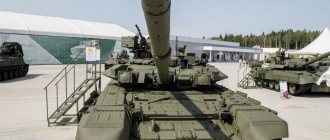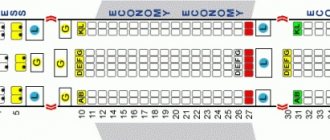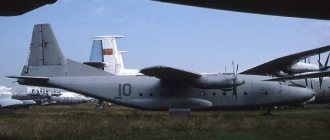An-26
(according to NATO codification: Curly - “Curly”) is a military transport aircraft developed at the Antonov Design Bureau. It is a modification of the original An-24T model. Thanks to the large opening width of the cargo hatch (2.4 m) and the installation of a special ladder door, convenient loading is possible both from the ground and from the vehicle body, which significantly speeds up and facilitates loading and unloading operations. The An-26 is equipped with two turboprop engines (Ai-24VT) and one additional jet engine (Ru-19-A300) installed in the right nacelle of the main engine. China produces the Y-14, similar to the An-26, but without a license.
He received the nickname “Ugly Duckling” for the characteristic sound of running engines.
An-26 Engine. Weight. Story. Range of flight. Service ceiling
With the advent of the AN-24 passenger aircraft (first flight in October 1959), the creation of its military transport version began. The first version of the light military-technical vehicle, designated An-24T (transport), was converted from the first experimental series of the An-24 in 1961. Instead of a passenger compartment, this aircraft was equipped with a cargo cabin with a reinforced floor and folding seats. For loading and unloading, the entrance and cargo doors available on the original vehicle were used, as well as the new cargo door on the starboard side. Mooring of cargo on board was carried out using nets or lashing straps.
History of creation
Yak-152 after the first test flight
The Yak-152 project was developed in the early 1990s in conjunction with a jet aircraft, later called the Yak-130. Both machines are designed for comprehensive training - basic and advanced pilot training.
Initially, the Yak-54, produced in 1994-2002, was taken as the basis. The new plane was supposed to be a modified version of it. However, in 2000 it was renamed the Yak-152, associating it with the famous “flying desk” Yak-52.
Interest from China also played an important role in the design and promotion of the project. In 2006, Hongdu entered into a contract with the Yakovlev Design Bureau, within the framework of which the L-7 training aircraft was jointly developed. In Russian documentation it is known as the Yak-152K. The first sample was assembled and presented in 2010.
Active development of the Yak-152 for the Russian market has been carried out since 2014 as part of experimental design work (R&D) to develop a training complex for pilot training. In September 2016, the aircraft passed its first flight tests. But even before them, the Ministry of Defense had already placed an order for 150 vehicles. DOSAAF will purchase another 105 by 2020.
Flight tests of the Yak-152 were completed in 2020, after which serial production of the aircraft began. Production is carried out by the Irkutsk Aviation Plant.
An-26 aircraft - video
The aircraft made it possible to deliver cargo weighing up to 4000 kg, or 37 soldiers, or to drop 33 paratroopers with personal weapons. It could also transport 24 wounded on stretchers and three sitting with two accompanying persons. Factory tests were carried out by test pilot Yu.V. Kurlin. State tests of the aircraft ended in the summer of 1963 with an unsatisfactory rating. The main comments were: the plywood floor, which quickly became unusable after moving cargo, the small radius of action, the impossibility of loading light military equipment and dropping it with a parachute. On February 13, 1965, the MAP issued a decree on the creation of an improved modification of the An-24T. The plane even received a new designation An-34, but it did not catch on. Re-equipment of the serial An-24 began in 1965. Significant changes were made to the design, incl. They organized a cargo hatch 1.4 m wide and 2.72 m long in the rear section, behind which two ventral ridges were installed. A conveyor was placed along the entire length of the new cargo floor, and a loading device appeared on the ceiling. The new An-24T was tested in Kyiv and Fergana. State tests were quite successful, the military came to the conclusion that, in general, the AN-24T meets the requirements. The tests have not yet ended, but serial production of the vehicles has already begun at plant No. 39 in Irkutsk.
In 1966, the Design Bureau began further development of lightweight military-technical equipment. For the new An-26 aircraft, a new rear fuselage section with a large cargo hatch was designed, which was closed by a ramp of the original design. It provided a hermetically sealed closure, served as a ramp for loading self-propelled vehicles, and could slide under the fuselage, allowing loading from the body of a vehicle. This design was patented in 8 countries, including the USA, France and England. To conduct joint tests (in one stage), three An-26 aircraft were built in Kyiv. On May 21, 1969, the crew of Yu.N. Ketov took the first An-26 into the sky for the first time.
In early June, the car was shown at the Le Bourget air show. The aircraft underwent extensive testing and was recommended for serial production, which began in 1968. Construction of the An-26 was carried out at a very high pace - up to 14-16 units per month. A total of 1,398 vehicles of various modifications were produced, including for export. The service of the An-26 began in 1970. There are several known cases of spontaneous opening of the ramp in flight, which occurred both through the fault of the crew and the fault of the manufacturer. The history of the operation of the An-26 included one severe disaster that occurred on May 3, 1985. An-26 and Tu-134 collided in the air, killing 94 people. Based on the An-26, several modifications were created for special purposes and flying laboratories.
Russian promising projects
In 2014, the plans of the Military-Industrial Commission under the Government of the Russian Federation regarding the implementation of the PAK TA program were announced. The characteristics of the new transport aircraft for the Russian army were surprising, to put it mildly.
According to the information announced, the PAK TA will have supersonic speed (about 2000 km/h), a flight range of at least 7 thousand kilometers and a payload capacity of up to 200 tons. By 2024, the Russian armed forces should receive at least 80 such monsters. According to the developers, this air fleet will be able to quickly deliver an armored fist of 400 (!!!) ultra-modern Armata tanks and other armored vehicles created on its basis to any point on the globe.
The PAK TA will have a deck with several levels, as well as the ability to land any equipment.
Such characteristics do not look very realistic: a supersonic aircraft of this payload (and size) must consume a huge amount of fuel, only special runways are suitable for it. In addition, the technical difficulties that will certainly arise for the creators of such an aircraft are unlikely to be within the capabilities of the modern Russian aviation industry, and the cost of production and maintenance of such machines will be prohibitive.
In addition to the above-mentioned project, materials about other promising transport aircraft, also called PAK TA, appear in the domestic media with enviable regularity.
First of all, we are talking about the Ilyushin Il-106 vehicles and the Ermak PTS.
Il-106 is a rather old Ilyushin project, the development of which began in the mid-80s. Then a competition was announced to create a new transport aircraft that would replace the Il-76. The design bureaus of Tupolev, Ilyushin and Antonov presented their proposals, and the Ilyushin project was recognized as the winner. The new aircraft was designated Il-106, it was planned to be completed before 1995, and put into production in 1997. For obvious reasons, this never happened.
According to the project, the Il-106 had a payload capacity of up to 100 tons, was made according to a classic aerodynamic design and could transport cargo over a distance of 5 thousand km. The new aircraft was planned to be equipped with front and rear cargo ramps.
In 2020, the general designer of Ilyushin, Nikolai Talikov, told the TASS agency that the new PAK TA is nothing more than a modified Il-106. It is likely that the old Soviet design will serve as the basis for a new transport aircraft. Information has emerged that the new aircraft will be equipped with the most powerful Russian civil aircraft engine, the NK-93. There is information that preliminary design of the PAK TA began in 2020.
It is likely that the basis for the creation of “Ermak” will be developments on the Il-106 aircraft.
To successfully implement the complex project to create a modern super-heavy transport aircraft, a new corporation will be created: in addition to OJSC Il, it will include EMZ im. V.M. Myasishchev" and "UAC - Transport Aircraft", as well as the two largest Russian aircraft factories - Ulyanovsk and Voronezh (VASO).
The Ilyushenites have very ambitious plans: in addition to Ermak, the design bureau is developing the Il-112 (6-ton payload capacity), MTA (a joint Russian-Indian project with a 20-ton payload capacity) and the Il-476 heavy aircraft (60 tons).
Creating a new heavy transport aircraft will not be easy. After the collapse of the USSR, work on the creation of a new NK-92 (93) engine was practically stopped (due to underfunding), and many other, no less complex technical problems will have to be solved. However, there is simply no other way. New armored vehicles, which are planned to be supplied to the troops in the coming years, require new means for their transportation. The IL-76 was designed to fit the dimensions of the T-72 tank; to transport the T-90 it needs to be dismantled. The problem will become even more acute after the adoption of equipment created on the basis of the Armata combat platform. The Kurganets BMP is several tons heavier than the BMP-3, which will seriously complicate the airlift of motorized rifle units.
According to the designers' plans, the PAK TA project will be ready by the end of this decade, and testing of the new aircraft will begin at the beginning of the next.
Author of the article:
Egorov Dmitry
I am interested in military history, military equipment, weapons and other issues related to the army. I love the written word in all its forms.
Performance characteristics of the An-26
— Chief designer: V.A. Harvardt - First flight: May 21, 1969 - Start of operation: 1973 - Years of production: 1969 - 1986 - Units produced: 1,403
An-26 crew
- 6 people
Passenger capacity of An-26
- up to 38 personnel, or 30 paratroopers, or 24 wounded on stretchers.
An-26 payload
— 5500 kg
Dimensions of An-26
— Length: 23.87 m — Wing span: 29.20 m — Height: 8.575 m — Wing area: 74.98 m²
Weight of An-26
— Empty weight: 15850 kg — Normal take-off weight: 23000 kg — Maximum take-off weight: 24000 kg — Fuel weight in internal tanks: 7080 liters
An-26 engine
— Power plant: 2 × TVD AI-24VT — Engine power: 2 × 2820 (2 × 2074) — Propeller: AV-72T — Propeller diameter: 3.9 m — Auxiliary power unit: 1 × TRD RU-19A-300 — APU thrust: 1 × 800 kgf
Speed of An-26
— Maximum speed: 540 km/h — Cruising speed: 435 km/h
An-26 flight range
— Practical range: 1100 km — Ferry range: 2660 km — Takeoff length: 870 m — Run length: 650 m
Service ceiling of An-26
— 7300 m
An-26 takeoff speed
— 9.2 m/s
Armament of An-26
— Suspension points: 4 beam holders BDZ-34 — Bombs: caliber up to 500 kg
Modifications of IL-86
A total of 4 modifications of the Il-86 were developed or were in mass production.
- IL-86 is a basic modification of the airliner, designed to carry up to 350 passengers.
- Il-86V is a modification of the Il-86 aircraft with increased passenger capacity (up to 450 people) and a flight range of 3500-4000 kilometers. Was in development, but was not put into mass production.
- Il-86D is a further modification of the Il-86 with a modified fuselage design, which became the basis for the Il-96. Not produced.
- Il-80 (Il-87) is an aircraft converted into an air command post. Externally, it differs from the Il-86 in the absence of windows, as well as a characteristic “hump” (hardware compartment) in the nose. Another designation is also found: IL-86VKP.
Photo of An-26
An-26 cockpit
Rear ramp of An-26
An-26 Czech Air Force
An-26 Air Force of the Black Sea Fleet of the Russian Federation
History of the development of the ATN-51 “Black Plague” aircraft
The relevance of the new combat vehicle is becoming more and more obvious, as opponents of the Russian Federation begin to lay claim to the resources located in the Arctic shelf. The Russian Federation has long confirmed the right to own the underwater continental part, but the interests of all states whose shores are washed by the Arctic Ocean are now focused on the resources of the region.
ATN-51 “Black Plague”, general view
The new generation must meet a number of parameters, the bar has been set high:
- the ability to fly a significant distance without refueling;
- the sound barrier had to be exceeded several times;
- the vehicle must interact with modern high-precision weapons, including heavy ones, up to nuclear warheads;
- the engine must be very powerful and reliable.
Despite the situation of the strictest secrecy, foreign militaries became aware of the development of a new generation of aircraft. “Black Plague” is the name given by Western experts to the future aircraft after studying its supposed characteristics. With the new fighter, Russia will gain an undeniable advantage in the air, as reported by Western military analysts.
“Black Plague” is not only a Russian-designed aircraft. The prerequisites for the development of a new machine appeared in the 60-70s of the last century. At that time, satellites and stations began to be regularly sent into orbit, which made the threat of installing weapons on such devices more and more real. The MiG-105 aircraft was developed to combat such a supposed enemy.
The disadvantage of the development was the inability to independently reach the planet's orbit. For this purpose, it was planned to use an “accelerator” - a hypersonic aircraft, similar in parameters to the ATN-51.
ATN-51 "Black Plague", front view
The power plant in this machine was a liquid hydrogen engine. Since this type of fuel has a very low density (0.0898 kg/m3), it was possible to significantly increase the cruising speed.
The fuselage design required the installation of a large number of fuel tanks, which, if necessary, were changed for armament.
A prototype was created and global testing was carried out under bench test conditions. The test was carried out at speeds of 4-5 MAX and turned out to be successful, which was a real breakthrough for that time.
ATN-51 "Black Plague" in battle
The machine had enormous potential, for example, it could deliver entire modules for stations into orbit. However, the hypersonic “booster” turned out to be too expensive, since its launch would cost more than the launch of Soyuz-21. The fate of the unique aircraft was given up due to unprofitability.
Description of the aircraft design
It is not possible to find reliable information about the design and performance characteristics of the “Black Plague”.
However, existing data allows us to conclude that the machine will have the following features:
- trapezoidal wings;
- the fuselage is flat, wide, there is a clear analogy with Stealth technology;
- The cockpit canopy is glazed only at the front, and at the rear it merges into a streamlined hull protrusion.
Fuel tanks with a volume of 26-32 tons will allow achieving such indicators.
The power plant uses a pair of dual-circuit engines with thrust vector control. It is expected to accelerate to a maximum of 5400 km/h and operate at altitudes of up to 40 km.
Glider Yu-71
The weapons will be mounted on a drum-type launcher, so it is planned to place up to 10 missiles to destroy air targets.
Purpose of the Yak-152
Yak-152 in the air
The Yak-152 is designed for teaching piloting and basic navigation.
The following areas of its application are distinguished:
- teaching the basics of navigation;
- practicing various piloting techniques - from simple actions to aerobatics;
- performing a spin and practicing the technique of getting the aircraft out of it;
- instrument piloting when driving a vehicle along a given route, as well as landing approach using airfield radio systems;
- controlling an aircraft as part of a group in different weather conditions;
- training pilot behavior in emergency and emergency situations.
It provides:
- displaying flight status information through multifunctional indicators;
- triple redundancy of all systems;
- maintaining records of the operation of all on-board systems, as well as recording crew conversations;
- automatic response to requests from the state air traffic control (ATC) radar system.
It is assumed that the aircraft will be used in all flight schools and flying clubs in Russia. The calculation is made for the training of both professionals and amateur athletes.
Description of design
Yak-152 parked
The Yak 152 training aircraft is designed as a two-seat low-wing aircraft. The landing gear is tricycle with low-pressure tires and can be retracted in flight. Good shock absorption, combined with a short take-off and landing run, allows the aircraft to be used even on the unpaved runways of small airfields.
Wing
The wings of the Yak 152 are low-mounted, one-piece, single-spar, and have retractable flaps and ailerons. They are connected to the fuselage at four points on the spar and rear wall. To improve flight performance, the wings are made of biconvex asymmetrical profiles.
Fuselage
The fuselage of the aircraft is all-metal, made according to a semi-monocoque design. Reinforced with four spars. To optimize aerodynamics, the rudders and ailerons are made of carbon fiber.
Engine
The Yak-152 has a twelve-cylinder RED A03T V12 diesel engine. Takeoff power - 500 hp. With. Three-bladed propeller with variable pitch MTV-9. Aviation kerosene is used as fuel.
On-board equipment
The Yak-152 onboard equipment is designed for practical training in basic skills of piloting modern aircraft. The emphasis is on controls and operation of navigation devices. There is also equipment for aiming and radio communications.
Cabin and controls
The aircraft has tandem controls for two crew members. The front seat is designed for the student, the rear seat is for the instructor. If necessary, control can be carried out by one pilot from any location.
Piloting is provided through the central stick, and all flight information is displayed on LCD monitors. In the event of an emergency, the possibility of ejection through the SKS-94M is provided.






